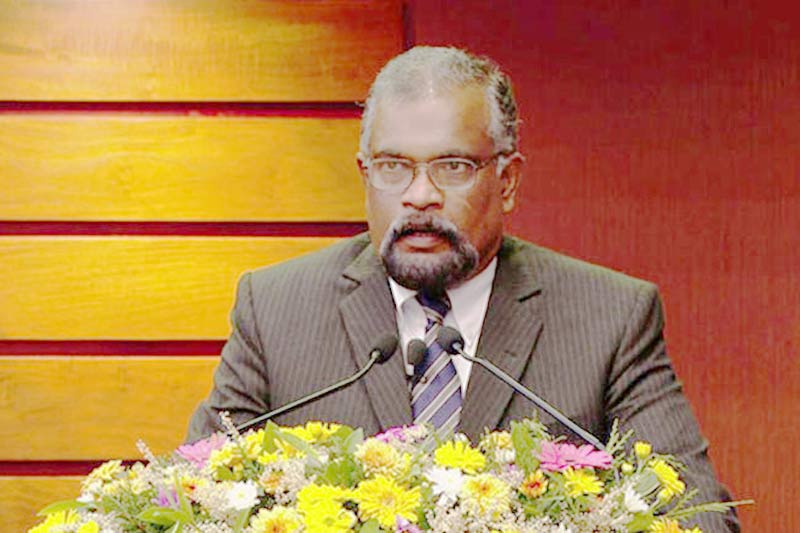Thursday Apr 24, 2025
Thursday Apr 24, 2025
Thursday, 4 July 2024 04:05 - - {{hitsCtrl.values.hits}}

Treasury Secretary Mahinda Siriwardana
Treasury Secretary Mahinda Siriwardana yesterday set the record straight with regard to perceived increase in the country’s debt stock at the end of March 2024 as well as some undermining the agreements reached on External Debt Restructuring (EDR) with official creditors.
Speaking at the Awareness Building Workshop on proposed Trade National Single Window System Project, yesterday in Colombo, Siriwardana said the Central Government debt, which was Rs. 28,696 billion as at end 2023, declined in nominal terms to Rs. 28,484 billion by March 2024.
“The decline is more significant when considering debt as a percentage of GDP as is the appropriate instrument for comparison over time. In spite of these improvements, it is indeed unfortunate that public understanding of these matters is often distorted by incorrect analysis which is either driven by incompetence or mischief,” opined the Treasury Secretary.
He described widely circulated posts in social media as well as some professional economists and finance professionals claiming that debt has increased during this period to $ 100 billion by the end of March 2024 from $ 96 billion as at end December, as “a very pathetic situation”.
Siriwardena said a simple comparison of the rupee figure and the US Dollar figure should make it abundantly clear that the perceived increase in US Dollar terms is due to the translation impact of the appreciation of the Sri Lankan rupee against the US Dollar during this period.
Despite the actual decline of the debt stock by end March 2024 (mainly reflecting the appreciation of the rupee), the message that is being circulated in the society unfortunately is that the debt stock has increased by $ 4 billion.
The Treasury Secretary also said similarly there is incorrect analysis of the debt restructuring process as well.
“Many have interpreted debt relief as purely being determined by the size of the nominal haircut on outstanding capital. Whereas even a basic understanding of finance would make it clear that debt relief is calculated by the discounted value of cash flow relief provided through a combination of grace periods, interest rate reductions, maturity extensions, and nominal haircut on capital, if any. It is very unfortunate that even professional economists have been trying to make false comparisons on debt relief by looking only at a single restructuring component in a meaningless manner,” Siriwardena pointed out.
“The seemingly malicious interpretation of data and the propagation of such incorrect information is very harmful to a democratic society like ours. It can very easily lead to the reversal of the economic reforms that have helped the country restore economic stabilisation and embark on the path of recovery. In fact, I should emphasise here the fact that it is the failure to heed to professional analyses and evidence based policy that was a major contributor to the country’s deep, complex and worst ever economic crisis since independence in the first place. I trust that at least now, we all will learn from these mistakes of the past,” Treasury Secretary emphasised.
Siriwardena recalled that during the last two years since mid-2022, the Government has been implementing a comprehensive set of macroeconomic reforms to address the root causes of the economic crisis. “At the centre of these reforms are fiscal reforms, with a focus on revenue based fiscal consolidation. Whilst these reforms have been painful, they are now beginning to yield positive results,” he stressed.
President Ranil Wickremesinghe on Tuesday told Parliament that as per the MoU signed with the Official Creditor Committee co-chaired by India, Japan, and France, as well as the EXIM Bank of China, Sri Lanka has secured a grace period until 2028 for repaying the principal loan. Additionally “significant” reductions have been made to the interest rates, with the new rate set at 2.1% or lower.
He said the repayment period for clearing the entire loan has been extended by eight years, meaning the debt should now be fully settled by 2043. “There is flexibility to gradually increase principal loan repayments, allowing us to defer loan servicing costs. This has resulted in Sri Lanka retaining a debt service of $ 5 billion,” Wickremesinghe added.

Discover Kapruka, the leading online shopping platform in Sri Lanka, where you can conveniently send Gifts and Flowers to your loved ones for any event including Valentine ’s Day. Explore a wide range of popular Shopping Categories on Kapruka, including Toys, Groceries, Electronics, Birthday Cakes, Fruits, Chocolates, Flower Bouquets, Clothing, Watches, Lingerie, Gift Sets and Jewellery. Also if you’re interested in selling with Kapruka, Partner Central by Kapruka is the best solution to start with. Moreover, through Kapruka Global Shop, you can also enjoy the convenience of purchasing products from renowned platforms like Amazon and eBay and have them delivered to Sri Lanka.
Discover Kapruka, the leading online shopping platform in Sri Lanka, where you can conveniently send Gifts and Flowers to your loved ones for any event including Valentine ’s Day. Explore a wide range of popular Shopping Categories on Kapruka, including Toys, Groceries, Electronics, Birthday Cakes, Fruits, Chocolates, Flower Bouquets, Clothing, Watches, Lingerie, Gift Sets and Jewellery. Also if you’re interested in selling with Kapruka, Partner Central by Kapruka is the best solution to start with. Moreover, through Kapruka Global Shop, you can also enjoy the convenience of purchasing products from renowned platforms like Amazon and eBay and have them delivered to Sri Lanka.